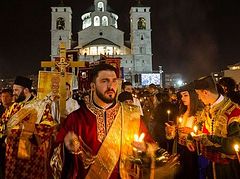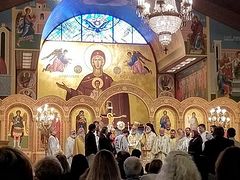With the outbreak of the Coronavirus we hear calls repeatedly from many priests and hierarchs to practice social distancing, avoid attendance at Liturgy, and rely instead on viewing the live-streaming of liturgical services. Is this good advice?
While temporary absence from liturgical services may be a necessary part of our response to the virus outbreak, the spiritual efficacy of live-streaming is seriously doubtful. Yes, for use in certain circumstances such as for those who are severely ill, bed-ridden or too weak to do anything other than view a television or computer monitor, live-streaming of the liturgy may serve a benefit. Certainly, the possibility exists that hymnography that is sung at live-streamed services may be heard by those who would otherwise be inattentive had they been physically present. Many have benefited from time to time by viewing liturgical services recorded on YouTube which are highly educational and often deeply inspiring. Why, then, would recorded or live-streamed services pose a spiritual hazard to us, especially at this time of grave illness and distress?
The answer is because in viewing a liturgical service in this manner, one additional barrier—the screen—stands between the viewer and the celebrant of the service. This one element, and the posture that it evokes in the viewer, is symptomatic of the very problem that liturgy poses for the modern person. By peering into a monitor to see something that we are meant, instead, to be actively participating in, the Liturgy is once again misunderstood and misused by such a viewer. Instead of being actively engaged as a member of the body gathered together and manifesting its fullness, the computer breaks down the oneness of Liturgy into isolation, separation and division. Indeed, the Coronavirus unleashes a devastating assault on Liturgy by upending everything that Liturgy is meant to be about. We are supposed to brush shoulders with our fellow members, not hold them at a distance of six feet. We are supposed to stand closely together as we work to join our voices in song, not worry about the spread of infection. We are supposed to share a meal intimately with our brothers and sisters, even sharing the very utensils, not eat privately by ourselves in a perfectly hygienic laboratory setting. Liturgy then, is meant to be reflective of life itself, which is neither neat nor clean. And Liturgy—properly understood—is meant to be work, not entertainment, a work that is corporate, not individual. We are meant to struggle, cooperate and work together to bring about the offering to God of the very things that He has blessed us to share in this life.
The computer monitor (what a telling symbol of modernity) simply continues and enhances the estrangement from Liturgy that we already experience, repeatedly. The fact is that for many of the laity, Liturgy is boring, too lengthy, incomprehensible and disconnected from daily life. In our utter passivity, the Liturgy is seen as something to be watched instead of something to be done. It is a peculiar duty to be discharged and acquitted of as easily as possible. It is modern man, seated passively in a pew with his legs crossed and his eye on his watch, who is completely unsympathetic and unaware of the reason, purpose and profound need for liturgical action. Perhaps this gravely estranged person (who is each of us) needs just such a tragedy to serve as an alert, to awaken him and her to an awareness of our complete dependency on God, on God’s mercy, and of God as the source and ultimate arbiter of life.
Now, if this is the experience of Liturgy that some, or many have when it is conducted within the walls of the temple, what kind of experience do we hope to have of Liturgy when we celebrate it—what has been called the liturgy after the Liturgy—in our homes? First, we must acknowledge with deep regret that for many Orthodox Christians, the home is simply not a place of prayer. We have fallen out of the custom and habit of prayer in the home. If we bother to maintain an icon corner in our homes, it remains for many merely a cultural adornment but not a living place of prayer. And for those who do regularly practice the discipline of daily prayer in the home, they know from experience that prayer conducted in this manner is, by definition, work and effort. To stand before the holy icons, to bow and prostrate oneself, to read the prayers out loud and to remember the names of our loved ones, takes time and effort. And it is this time and effort that actually connects our individual, private prayer with the corporate, public prayer of the Church. It is this reliance on the written prayers of the prayer book that unites us to the Holy Tradition of the Church and shapes our thoughts and perceptions. And so it is deeply ironic that when we are faced with an international threat to our health and well-being that some hierarchs are content to substitute the viewing of liturgical services for the exercise (the perfect word here) of personal prayer, instead of commanding the faithful to prostrate themselves before God. The idea that more of the very thing that is our problem, our passivity and complete lack of engagement, could be the solution to the problem, is astounding.
But there is a darker side to internet viewing. We have seen the ubiquitous spread of evil, vice and obscenity in a unique way via this medium. Images of the most sacred aspects of life have been captured and misused in the most base and profane ways. Intimate and beautiful things have been perverted and objectified purely for the sake of sensual pleasure. And now it is suggested that something that is extremely sacred—the liturgy itself—be viewed here. We forget, however, that the Liturgy has certain human requirements. Our worship has a physicality to it that is non-negotiable. We enter the Church (a place) and put lit candles before the icons. We smell the beeswax and the incense. The deacon tells us to bow our heads to the Lord, and we do it. The priest elevates the Lamb, fractions it and places it in the Cup precisely so we can eat it, not look at it. But now, for whatever reason I can’t meet the human requirements of the gathering, the sobor, the synaxis. Rather than recognizing that I am denied something that is ineffable and irreplaceable, in my modern, fallen instinct I prefer to have the same feelings I would if circumstances permitted me to do the necessary work (i.e., the Liturgy) even when I can’t or won’t do it. So I create an artificial world of images in order to gratify myself and produce those feelings. But the Liturgy is not offered for this purpose. Although it may produce feelings of deep emotion in the believer, the goal of the Liturgy is to call mankind to a higher and nobler reality, a noetic reality according to which we acknowledge the very limitations of creaturely life and experience. The path to this noetic reality, however, is not through subterfuge or by objectification, but by restraint of the passions, struggle and asceticism. At least this is what the saints tell us.
We forget that the Liturgy is hierophantic. When I was first ordained, photography was allowed but there were still those who remembered when it was not permitted inside a Church. The services are sacred and the ban of photography was intended to preserve their sacredness, to prevent their depiction as something common or banal. Indeed, something is lost when we artificially reproduce what is purely original in life.
The Coronavirus is a serious threat to our health, many have suffered and died as a result and, to be frank, more will likely suffer in the months ahead. Part of this suffering involves the interruption to our lives, our work, our celebrations, our economy. We need to come to terms with this and to mourn these losses, not paper over them with the appearance of normalcy. Our loss of the ability to celebrate the Liturgy with the regularity and frequency that we ordinarily would is also part of this suffering. We should acknowledge this and then redirect our grief into devout prayer to God, conducted in our homes and before the Holy Icons, in accordance with Tradition and through the prayers of our Holy Fathers.





